 |
|

|
 |
TABLE of CONTENTS
|
State awards $18 million in grants for transportation projects in seven communities |
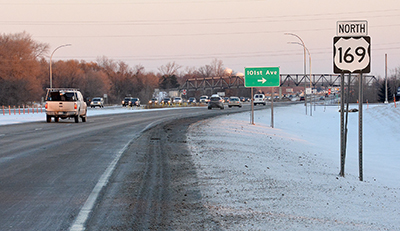
The Hwy 169 / 101st Avenue North interchange project will enhance traffic operations, improve roadway safety, and provide bicycle and pedestrian facilities for a segment of 101st Avenue North between Jefferson Highway and future Xylon Avenue. Photo by Rich Kemp |
MnDOT, in partnership with the Department of Employment and Economic Development, has awarded $18 million in grants for seven state highway projects that will support growing industry and businesses, leverage private funding and improve the transportation system for all users.
Three projects in the Twin Cities metro area and four projects in Greater Minnesota will receive a total of $18,197,450 as part of the state’s Transportation Economic Development Program, which the agency announced Jan. 2.
“Projects proposed under the TED program offer us an important opportunity to collaborate with our local partners and DEED to help enhance transportation and economic outcomes in Minnesota,” said Commissioner Charlie Zelle. “Those projects selected under this competitive program best demonstrated local government’s willingness to invest in the transportation system and the private sector partners’ commitment to job creation.”
“One of Minnesota’s strongest assets when it comes to economic development is its world-class infrastructure,” said DEED Commissioner Shawntera Hardy. “This program is a tool that allows Minnesota to maintain its high-quality roads, bridges and highways, in order to attract new businesses and talented workers.”
This year’s TED funds help leverage other federal, state, local and private funding for a total construction program of $130 million.
MnDOT received nine project proposals in the Twin Cities area and six proposals in Greater Minnesota, for a total of $67.6 million in grant requests.
More information about the selected TED projects is available on MnDOT’s website.
DEED administers a parallel Transportation Economic Development Infrastructure program that funds projects on local roads and for other types of transportation. Projects may combine funding from both programs. |
 |
|

|
 |
TABLE of CONTENTS
 |
Traffic deaths reach 43-year low |
By Sue Roe
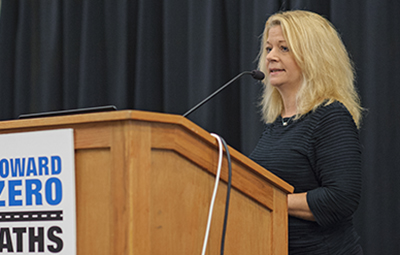
Kristine Hernandez, Statewide TZD program coordinator, spoke at the Northwest Minnesota TZD workshop in May. Photo by David Gonzalez |
In 2017, Minnesota traffic deaths were the lowest since 1974 and the second lowest since 1926.
Preliminary data from the Department of Public Safety last week shows there were 348 traffic deaths last year.
The work of the Toward Zero Deaths program uses education, enforcement, engineering, emergency medical and trauma services, courts and legislation to find solutions to reducing crashes, injuries and deaths in the state.
“When the Toward Zero Deaths program started in 2003, fatality numbers were at 655 and rising,” said Jay Hietpas, MnDOT state traffic engineer. “Through all of our hard work, we reduced fatalities by 47 percent and saved thousands of lives. This is an outstanding accomplishment, considering traffic fatalities are going up nationwide over the past few years.”
Kristine Hernandez, Statewide TZD program coordinator, said TZD’s success has come from focusing on best practices and looking at innovative approaches.
“TZD isn’t a silver bullet,” she said. “It’s a combination of people passionate about traffic safety and saving lives working together to change what is happening on our roadways, and listening to new ideas and approaches.”
"MnDOT employees can be proud of the work they’ve done to help reduce traffic deaths and injuries," said Sue Mulvihill, deputy commissioner and chief engineer.
“No matter where you work at MnDOT, we all have an impact on TZD. From our program delivery staff, who design safety into our projects, to our maintenance crews, who keep our roadways safe, to our office staff, that need to process the volumes of paper needed to make this organization run, we’ve all contributed,” said Mulvihill. “I particularly want to thank our Toward Zero Deaths coordinators, the Office of Traffic, Safety and Technology, and our district traffic offices. Your passion, innovation and dedication have truly made a huge difference.”
Of the 2017 fatalities, 98 were alcohol-related, 82 were speed-related, 80 were unbelted motorists and 16 involved distracted driving. |
 |
|

|
 |
TABLE of CONTENTS
 |
Right place, right time, right training allow Aeronautics employees to aid stranger |
|
By Dan McDowell, Office of Aeronautics
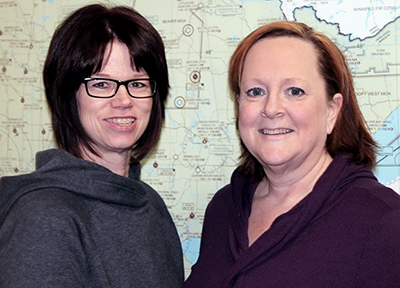
Jana Thompson (left) and Linda Connor, Office of Aeronautics, used the first skills they learned in a class at Aeronautics to assist a man having medical issues Dec. 21 at a restaurant in St. Paul. Photo by Dan McDowell |
It was a day like all days when Linda Connor, Office of Aeronautics office aircraft dispatcher, and Jana Thompson, Aeronautics aircraft registration, took a short lunch break. However, moments after entering the restaurant their day changed dramatically.
Connor and Thompson discovered a woman frantically asking the staff for help. Unfortunately, due to a language barrier, she was having trouble explaining what she needed. The woman’s husband had become extremely ill while at the restaurant and was in the restroom.
Thompson quickly responded to assess the gentleman’s condition, while Connor stayed with his wife to gather information to share with 911, if necessary. In moments, Thompson verified the man required emergency help and Connor immediately contacted 911. Meanwhile, Thompson remained at the man’s side to reassure him that help was on the way.
The man was experiencing breathing issues and Thompson supported him in an upright position while they waited for assistance to arrive. Both women continued to administer aid to him to provide minor relief and comfort.
Connor updated the emergency responders when they arrived regarding the current situation as they rushed to where Thompson who was holding the man upright and keeping him calm. The responders assessed the man’s condition and prepared him for transport to a local hospital.
Both Thompson and Connor reassured the man’s wife that he was in good hands and would be well cared for. They then retrieved their lunch order and returned to the Aeronautics office.
Thompson and Connor credit their rapid response and outstanding teamwork to the Adult CPR and First Aid training they received at Aeronautics only weeks before the encounter.
“We believe the training prepared us to confidently work together to aid a citizen in significant distress,” said Thompson. |
 |
|

|
 |
TABLE of CONTENTS
 |
Minnesota joins Pathfinder effort to become weather wiser |
By Sue Roe
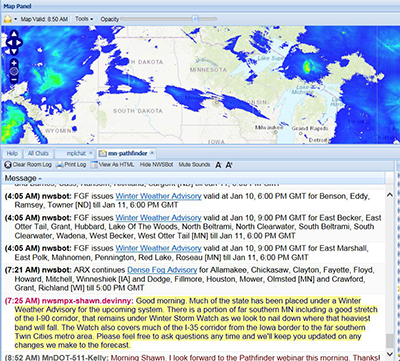
This screenshot shows what the chat room discussion looks like during a winter event. Representatives from the National Weather Service and MnDOT participate in the discussion. |
MnDOT is launching the use of a new strategy this month for communicating blizzard warnings to the public. Pathfinder is a collaborative effort with the National Weather Service to translate and share weather forecasts and road conditions into consistent travel impact messages.
Pathfinder, which is used in 17 other states, is a step-by-step process to determine what information to share with the public before, during and after weather events.
“Winter weather impacts safety, mobility, productivity, the environment and the economy,” said Kelly Braunig, 511 coordinator who co-leads the project with Garrett Schreiner. “Pathfinder helps inform travelers with clear and consistent messaging so they can make safe and efficient travel decisions.”
One of Pathfinder’s main tools is a chat room the National Weather Service and MnDOT use to exchange details about the impacts of weather on road conditions.
“The chat room is a great resource,” said Braunig. “This is where we discuss what the weather conditions are, how the roads are affected and what messages will best inform the public.”
Within MnDOT, maintenance operations, traffic operations and communications are involved in the Pathfinder process. These groups use the information to help make such decisions as how and when to treat the roads, staffing needs, what information to put on the 511 website, and what and when to tell the traveling public about road conditions in news releases, social media and dynamic message signs.
“People often use multiple sources for their weather and they will trust the messages if they are used consistently across multiple entities,” Braunig said. “The average public may not notice the use of Pathfinder except that messaging will be more clear, concise and impact-based.”
This collaboration will also strengthen the working relationship between NWS and MnDOT, although other entities involved include emergency management, law enforcement and local governments. Iteris, MnDOT’s private sector meteorological service, is also involved.
Planning for Pathfinder began in fall 2017 when maintenance, RTMC and communications employees met with NWS officials to identify contacts within the two entities and decide roles and responsibilities. Joe Huneke directed the project for maintenance.
Pathfinder unofficially got its start during the 2002 Winter Olympics when the Utah DOT and NWS coordinated weather forecasts and road conditions. The FHWA and NWS later worked with the Utah DOT to document the process. Nevada and Wyoming used the process before it officially became the Pathfinder Implementation Plan in 2014.
Pathfinder falls under the Federal Highway Administration’s Everyday Counts and Weather-Savvy Roads initiative.
The National Highway Traffic Safety Administration reports that 22 percent of all crashes in the last 10 years were weather-related. More than 445,000 people were injured and 5,897 people were killed. |
 |
|

|
 |
TABLE of CONTENTS
 |
Liquid potassium acetate shows promise in reducing chlorides |
|
By Sue Roe
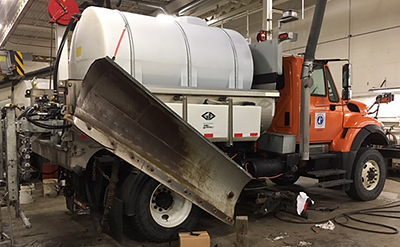
A truck at the Pike Lake truck station is outfitted with tanks to spray liquid potassium acetate in the Interstate 35 tunnels in downtown Duluth. Photo by Dennis Defoe
|
Two winters ago, the Interstate 35 tunnels in downtown Duluth were the scene of numerous crashes during one storm event. Although the inside of the four tunnels, that range between 500 and 1,500 feet long, are dry during many storms, the traffic can track in snow and ice, causing the tunnels to quickly become slippery.
“Some of our worst crashes were in those tunnels that day,” said Chris Cheney, District 1 maintenance operations superintendent. “The tunnels are all on a curve. It’s cold in there and when conditions are right, cars start sliding around.”
Maintenance crews sprayed the tunnel roadways with liquid potassium acetate, something that is usually used on airport runways and in some MnDOT automated spray systems on bridge decks. After one pass in each direction through the tunnels, the crashes stopped.
Since potassium acetate in the automated spray systems was already effective, Steve Baublitz, Duluth subarea supervisor, developed the pilot for its use as a deicer and anti-icer in mobile applications.
“Potassium acetate is showing the potential to reduce chloride use,” Cheney said. “This has the potential to significantly change the way we do winter operations in the state.”
Historically, potassium acetate isn’t used as commonly as salt because of the higher costs. Hovever, acetates have a lower effective temperature to melt snow and ice, are less corrosive to steel than chloride-based salts and may not have the long-term effects on surface and ground water that chlorides do.
Cheney said when District 1 tracked acetate performance compared with salt usage, costs were comparable with the acetate on some routes. He said crews used one-third to one-half less acetate than what manufacturers recommend compared to standard salt applications with the same results.
“Calibrating our usage helped us figure out the right amount to use,” he said. “Using 10 gallons per lane mile versus the manufacturer’s recommended rate was extraordinarily effective.”
Cheney said acetate costs are still about 20 percent more than the typical usage of salt, but that doesn’t include other associated costs such as labor and equipment. When those costs are included, potassium acetate costs are looking affordable.
So far this season, he said pavement regain times on the potassium acetate routes are comparable to salt.
“The public is seeing no difference in the road conditions from one route to the next,” Cheney said.
Acetates are not corrosive to steel but they do corrode zinc plating on steel. MnDOT hasn’t seen any significant impact to the galvanized steel used in locations that have fixed spray systems in more than 10 years of use.
Chlorides will corrode metal components, rebar in concrete, wiring harnesses and electronics in plow trucks and other equipment.
Acetates readily break down in water, unlike chlorides, but they consume oxygen as they break down and they are more toxic than chloride to aquatic life if concentrations are high enough.
“Last winter, District 1 used 37,000 tons of salt. Research shows that a large percentage of salt stays in ground and surface water for a long time,” Cheney said.
This winter, two District 1 trucks in the Duluth Subarea are designated for potassium acetate use. He said he would like to expand to additional routes for further evaluation.
He said although the results with potassium acetate are promising, further study will establish data for best practices, application rates and route cycle times. More equipment will be needed to expand the effort and for more precise control of applications. Additional storage tanks also will be needed at truck stations.
“We need to find an alternative to road salt and continue to keep the routes safe for the traveling public,” he said. “This is too important to not continue.”
Research is planned to address the operational evaluation and environmental issues for the 2018-19 season, according to Bob Vasek, maintenance operations engineer. He said District 1 will continue its trial and expansion of capabilities this year. The research proposed will include application rates, equipment and infrastructure impacts as one portion, and the environmental impacts as a companion study.
For example, Vasek said research will determine where acetate breaks down, such as the road surface, ditch and in water, and what effects acetate has on electrical systems and equipment.
“This research will help us find ways to mitigate the effects of acetate through roadway design or other treatment methods to make it more environmentally friendly,” he said. |
 |
|

|
 |
TABLE of CONTENTS
 |
Snowplow fuel reduction among latest research picks |
By Shannon Fiecke, Research Services and Library
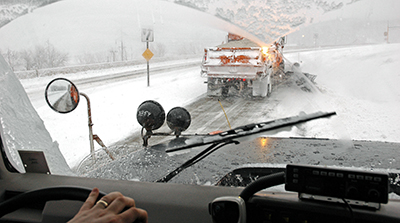
A new MnDOT research project aims to reduce snowplow fuel usage by analyzing plow data to optimize routes. Photo by David Gonzalez |
Each winter, MnDOT’s snow and ice removal operations consume over one million gallons of diesel fuel, at a cost of over $2 million to taxpayers.
A proposal for reducing fuel usage by optimizing snowplow routes – which requires complex data analysis by University of Minnesota researchers – was among 27 new research projects selected last month by the governing boards for MnDOT and the Local Road Research Board for FY2019 funding.
By analyzing vehicle performance data that’s already being collected from the Automated Vehicle Location technology installed on many MnDOT plow trucks, the agency hopes to improve the efficiency of snowplow routes and bring these numbers down.
“Plow route optimization can reduce labor and material costs—fuel, salt, etc. — and, potentially, improve safety by giving plow operators more time to focus on problem snow areas, while still clearing the full roadway network,” said Joe Huneke, Road Weather Technology supervisor.
Other notable projects include:
- A methodology to assess old MnDOT bridge barriers for replacement or rehabilitation
- Evaluation of the economic impact of rural transit service in Greater Minnesota
- Testing of a wayfinding smartphone application for the visually impaired at signalized intersections operated by MnDOT in downtown Stillwater
Huneke’s project is an extension of the Maintenance Decision Support System/Automated Vehicle Location technology, which helps snowplow operators select the right amount of deicing chemicals for roadway and weather conditions.
The plan is to tap data available from MDSS/AVL – weather condition, salt usage and level of service information – along with the vehicle performance data, to identify “hotspots” for high snowplow fuel usage and possible snow fence locations, and routing and equipment changes for reducing fuel consumption. For example, possibly adjusting routes to reduce the amount of deicing material a truck is hauling on a particular route.
Over the next few months, teams of transportation practitioners from MnDOT, cities and counties will form to develop and oversee the newly funded research projects, which begin in FY2019.
For all newly funded projects, see this list. Previously funded Minnesota transportation research projects can be searched here. |
 |
|

|
 |
TABLE of CONTENTS
 |
Kristi Schroedl named new Chief Financial Officer |
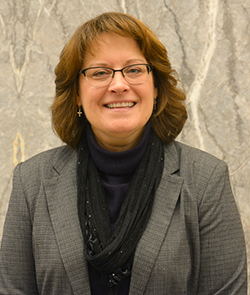
Kristi Schroedl is MnDOTís new Chief Financial Officer. Photo by Rich Kemp |
Kristi Schroedl will serve as MnDOT’s Chief Financial Officer, replacing Tracy Hatch, who left to pursue new opportunities with Metro State University. Schroedl, who took over as the CFO Jan. 10, will report directly to the commissioner and be a part of the Executive Leadership Team and the Senior Leadership Team.
“I’m delighted to have Kristi assume the role of CFO,” said Commissioner Charlie Zelle.
Schroedl first joined MnDOT in 2010, serving as the agency’s budget director and later as assistant director in the Office of Financial Management. Since late 2014, she directed the development and implementation of the Contracts Agreements Auditing Tracking System, or CAATS application, on behalf of the Office of the Chief Counsel and supported the Office of Civil Rights as part of the leadership team.
Prior to MnDOT, Schroedl worked for six years at Minnesota Management and Budget where she led the statewide budget system and fiscal note system for all state agencies. She also served as an Executive Budget Officer at MMB, working with state government agencies, including the Legislature, MNIT, constitutional officers and the then-Department of Finance/Employee Relations. Her state career started at the Department of Revenue, where she worked for 14 years.
The offices of Financial Management, Resource Management, and Audit will report to the new Chief Financial Officer.
“I am excited to be back in the budget/finance arena and honored to serve as MnDOT’s CFO,” said Schroedl. “My work on the program side over the past few years has broadened my appreciation for the complexity of the important work we do every day. I look forward to productive working relationships in managing MnDOT’s finances.”
With the departure of Hatch, the agency will operate with a single deputy commissioner in Sue Mulvihill. Tim Henkel, assistant commissioner for Multimodal Planning and Program Management, Sue Stein, assistant commissioner for Corporate Services, and Dan DuHamel, agency business director, will now report to Mulvihill.
Strategic Programs Director Jocelyn Stein and the WIG project team now report to Eric Davis, chief of staff.
“I’m confident these organizational changes will keep our agency moving ahead with minimal disruption,” said Zelle. “I’m so proud of all we have accomplished together over these past five years and I look forward to what all of us working together will accomplish in the months and years ahead.” |
 |
|

|
 |
TABLE of CONTENTS
 |
Center provides training, resources to help small businesses thrive |
By Mary McFarland Brooks
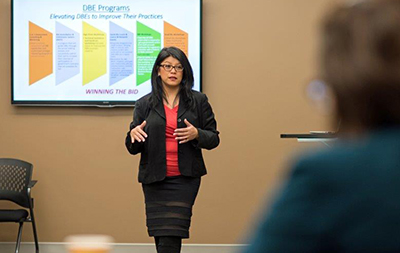
R. Lynn Pingol is the director of MnDOT's Learning Hub and Small Business Resource Center. Photo by David Gonzalez |
Build it and they will come. The Small Business Resource Center opened its doors in 2017 at Spruce Tree Centre, located at Snelling and University in St. Paul, convenient to both metropolitan areas. The compact center contains computers and work spaces, along with hands-on help in understanding project plans and how to bid projects. Classes are also available for sharpening skills necessary to compete for contracts on transportation projects and for Disadvantaged Business Enterprises to act as subcontractors themselves.
MnDOT is finding that DBEs and other certified small businesses are showing up and signing up for classes regarding bidding on MnDOT projects and contracts, along with other skill-building opportunities.
The MaKee Company was hired by the Office of Civil Rights as the consultant to provide the hands-on assistance that has small businesses coming through the door.
“It is exciting to be leading this effort to create space where DBEs can network, partner and learn necessary business skills to compete on construction projects,” said R. Lynn Pingol, MaKee Company CEO.
Pingol’s background in developing small businesses both nationally and internationally has provided her with the expertise to relate to the challenges facing certified small businesses locally. Her knowledge in construction provides the credibility these businesses need to help bridge that gap.
Some examples of the types of assistance and resources offered at the SBRC include:
- Learning the bid assimilation and submission system – From breaking bids down, preparing the bid documents and understanding the spec book and plans
- Building technology skills through progressive workshops
- Receiving one-on-one mentoring, coaching and building site visits
The SBRC is encouraging and assisting DBEs to participate in MnDOT’s Negotiated Maintenance Contracts. The NMC’s will help them hone their skills, gain actual on-the-job experience and feedback from MnDOT project engineers. Once they successfully fulfill the NMC contract, these small businesses can then qualify to receive another North American Industry Classification System certification in additional types of work, expanding their capacity and allowing them to compete on other projects.
For example, MnDOT hires a DBE with experience as a residential landscaper. Under the NMC, they will work on a MnDOT maintenance or construction project, learn to read specs, understand the scope of work and have their efforts and quality of work reviewed by MnDOT engineers. Once the small business owners can demonstrate experience on state construction projects they are more likely to be hired for other assignments by private and public companies. The biggest take away for DBEs who participate in NMCs is that they will experience what it is like to work as a general contractor – working directly with a client, in this case MnDOT, and not as a sub-contractor or a second-tier contractor.
“In 2017 the SBRC established itself as going to bat for DBEs and in 2018 the OCR looks forward to building and expanding on those efforts,” said Ashanti Payne, Office of Civil Rights business and program development manager.
For more information about upcoming training at the SBRC, visit the MnDOT Office of Civil Rights event calendar. |
 |
|

|
 |
TABLE of CONTENTS
 |
Employee newsletters digitized through library |
By Qin Tang, MnDOT Library
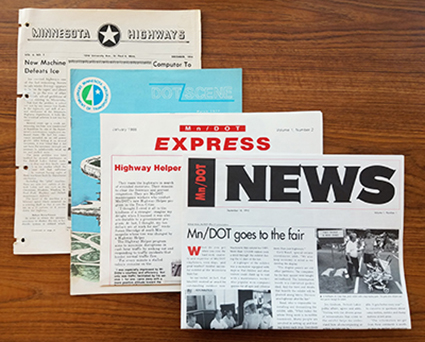
Employee newsletters are now digitized and keyword searchable online via Minnesota Reflections. Photo by Jim Byerly |
MnDOT Library accomplished another digitization milestone. All printed MnDOT employee newsletters are now digitized and keyword searchable online via Minnesota Reflections, provided by the Minnesota Digital Library.
The newsletters capture a snapshot in time and provide a valuable resource for historical information about the department, including timelines, dates and photos.
The following is a timeline of the MnDOT employee newsletters which have changed in titles, sizes and formats over the last 60 plus years.
- Minnesota Highways [Nov. 1951-Oct. 1976]
- DOT Scene, [Nov. 1976 – Sept./Oct. 1987]
- Mn/DOT Express [Dec. 1987 – Summer 1995]
- Mn/DOT Express Focus [May 1995 – Oct. 1996]
- Mn/DOT News [Sept. 1995 - Jan./Feb. 2001]
- DOT Connection [April 4, 2000 – Feb. 12. 2001]
- MnDOT Newsline [Feb. 14, 2001 – present] “Mn/DOT News” (print) and “DOT Connection” (online/email) were merged and replaced by the current Web-based “MnDOT Newsline.”
The current Newsline is available at http://www.newsline.dot.state.mn.us. All the previous issues are available in the Newsline Archive at http://newsline.dot.state.mn.us/archive.html. The newsletters prior to Newline are available via Minnesota Reflections. |
 |
|

|
 |
TABLE of CONTENTS
 |
Enrollment for Leadership Development Program closes Jan. 19 |
Employees’ motivation and willingness to improve their competencies allows MnDOT to remain adaptable and productive, and ultimately provides quality service to its customers. This can easily be achieved through the Leadership Development Program, with little to no expense, other than one’s time and attention, according to Carol Hennekens, the Leadership Development Program manager.
“Employees are realizing the benefits of participating in the program and using its resources to assist them with their development,” she said. “The 2017-2018 program year, which started in September, is offering many new learning opportunities and additional resources that will support new as well as past participants who want to enroll again.”
Open to all employees, the program is individually customized and flexible to meet participants’ development goals. It can be structured, informal, rigorous, ongoing and flexible all at the same time. This unique program requires participants to create their own development goals and set their own development schedule to fit their busy work schedule.
Group 10 program year begins March 1 and goes through Jan. 25, 2019. To learn more about the Leadership Development Program and how to enroll in Group 10, visit the LDP website. You can also contact Carol Hennekens, Shawn Meade or Amanda Klawiter. |
 |
|

|
 |
TABLE of CONTENTS
 |
Governor proclaims Jan. 8 as Tribal State Relations Training Program Day |
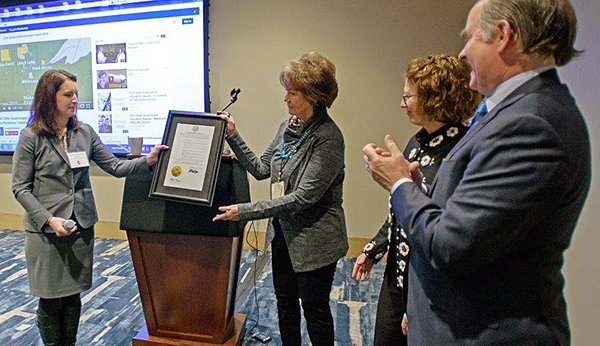
Joanna Dornfeld, Gov. Daytonís chief of staff, presents the proclamation to Linda Aitken, training manager, MnDOTís Tribal-State Relations Training program, while Roxanne Richards, director, Continuing Education Program, UMD Center for Economic Development, University of Minnesota/Duluth Department of American Indian Studies and MnDOT Commissioner Charlie Zelle observe. More than 2,000 state agency employees have taken the Tribal State Relations Training since its inception in January 2012. Participants learn about American Indian Tribal governments, histories, cultures and ways of life in this unique government-to-government training program. Photo by David Gonzalez |
|
 |
|

|
 |
TABLE of CONTENTS
 |
Employees raise money, gifts for their communities this holiday season |
By Dana Hernandez and Judy Jacobs
Each year, MnDOT employees show the true meaning of the holidays by giving back to their coworkers and local communities, helping others in need. 2017 was no exception and may have even surpassed efforts from previous years. Some of these charitable efforts include:
District 1
District 1 participated in Toyland Express. This year they were able to collect 78 toys, three gift cards and $150 compared to last year’s round-up of 36 toys and $200 donations.
“District 1 has been collecting toys for Toyland Express since 2012,” said Cindy Yost, event coordinator and accounting technician for District 1’s Business Office. “Each year the donations increase as more people participate. We were able to more than double the amount of toys received this year over last year as well as cash contributions. It’s really rewarding to be a part of this event.”
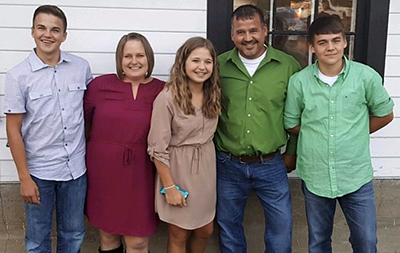
District 2ís Alan Vleck and his family were the recipients of this yearís fundraising efforts by district employees. Photo courtesy of the Vleck family |
District 2
Every year, District 2 uses the holiday season to gather donations to support an employee or their family. This year, that initiative was for Alan Vleck from the Bemidji Truck Station.
Vleck has been working to heal from an accident over the last year, as he has been diagnosed with Cervical Dystonia, a neurological muscle disorder. Coworkers were able to raise $1,596.50 to help him and his family get through this difficult time.
"Thanks again for all your caring and support, I just honestly don't know what we would have done without it," said Karen Vleck.
District 3 and AFSCME
District 3B/St. Cloud held a Toys for Tots fundraising lunch over the holiday season. Retired Marine Steve Titus and his wife have been picking up District 3’s donations for the past 11 years. They are grateful for MnDOT’s generosity. The AFSCME union was also able to donate $300 to Toys for Tots. The donation total was $2,230 and 80 toys, the most they have ever raised.
Six of the donated toys were bicycles, which was part of the “Granite”/St. Cloud truck station donation efforts.
District 3A/Baxter held a drive which raised $1,163.
District 4
Employees in District 4 raised $2,200 for Hospice of the Red River Valley this holiday season. Employees have been holding a fundraiser every December since 1995 to raise funds for Hospice. This year’s contributions brought the grand total of monetary donations to $31,774.
District 6
District 6 participated in the Toys for Tots campaign again this year. District 6 has collected toys at its facilities in Owatonna, Rochester and Winona for several years.
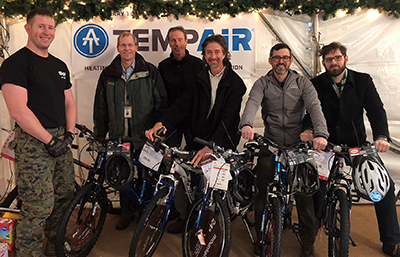
MnDOT employees representing the Capitol United Cycling Club donated bikes and helmets to the Marine Toys for Tots drive. From left: U.S. Marine Sgt. Steven Sample; Tim Henkel, assistant commissioner of Modal Planning and Program Management; Mike Schadauer, retired; Tom Styrbicki, state design engineer; Ben Crow, former MnDOT employee, and Andy Trcka, MNIT. Photo courtesy of KARE 11 |
Employees also participated in the Polar Plunge, which provides funding to Special Olympics Minnesota. District 6 has a team that participates each year and plans to plunge again this year on Feb. 10 in Rochester.
District 7
District 7 partnered with the local State Patrol in its 10th year of collecting for Toys for Tots. This year there were 224 new, unwrapped toys donated along with cash donations of $665. This was a new donation record for the district, as the program continues to grow every year. The toys were picked up by the Mankato Area Marine Corps League on Dec. 14. The program distributes toys locally to more than 3,000 children in South Central Minnesota.
Bridge Office
The Bridge Office held a silent auction to benefit the victims of Hurricanes Irma and Maria. Employees donated hand-made items, as well as gift baskets and other items. The office raised over $600. Money received was given to the Elfondo Boricua organization, a fund of the St. Paul Foundation. Donations will be going directly to assist with, by, and for the people of Puerto Rico who are victims of the hurricanes. One hundred percent of the donated funds will go to legitimate vetted non-profits that help in medical and social services.
Office of Environmental Stewardship Social Committee
In November, the Office of Environmental Stewardship (6th and 7th floor at Central Office) Social Committee conducted a coat drive for Joseph’s Coats.
“Teresa Martin was the heart and soul of this coat drive,” said Lynn Clarkowski, Office of Environmental Stewardship director. “So many employees donated to this cause. We are so very grateful.”
Approximately 25 garbage-sized bags, filled with new and gently used clothing, were collected for Joseph’s Coats.
“The team at Joseph’s Coats was very grateful for the donations,” said Clarkowski.
Capitol United Cycling Club
MnDOT employees involved in the Capitol United Cycling Club completed their second Annual Bob Prudhomme Memorial Ride. Charitable donations from this event allowed the club to purchase six new kid’s bikes and six new bike helmets and donate them to Toys for Tots.
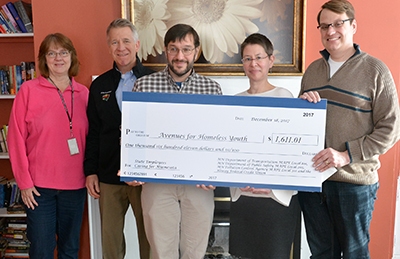
MnDOT and MAPE Local 801 collected donations for the Avenues for Homeless Youth. Pictured from left to right are Nancy Stone, State Aid and MAPE Local 801; Mark Hodowanic, Hiway Federal Credit Union; Mark Snyder, Minnesota Pollution Control Agency, MAPE Local 301; Katherine Meerse, Avenues Executive Director; Craig Freeman, Avenues Community Engagement Manager. Photo by Rich Kemp |
“It’s really gratifying,” said Tom Styrbicki, MnDOT’s state design engineer. “Not only to be able to ride with this group of active cyclists, but to also give bikes and helmets to children who wouldn’t have a bike to ride.”
MAPE locals and Hiway Federal Credit Union
MnDOT and MAPE Local 801 collected monetary contributions for Avenues for Homeless Youth. The mission of Avenues for Homeless Youth is to provide emergency shelter, short-term housing and support services for homeless youth in a safe and nurturing environment. More information about this organization can be found at: http://avenuesforyouth.org/about/.
Also contributing to this effort were MAPE Locals 301 (Minnesota Pollution Control Agency) and 502 (Minnesota Department of Public Safety). In addition, the Hiway Federal Credit Union contributed $250 to make a total contribution of $1, 611.01 to Avenues for Homeless Youth. |
 |
|

|
 |
TABLE of CONTENTS
 |
WIG effort helps MnDOT advance equity |
By Eric Davis, chief of staff

Eric Davis is MnDOTís chief of staff. Photo by Rich Kemp |
“Injustice anywhere is a threat to justice everywhere.”– Dr. Martin Luther King, Jr.
This coming weekend, we are invited to once again pause and reflect on the life and work of Dr. Martin Luther King, Jr, to help advance equity and ensure civil rights for all people regardless of race or the color of their skin. In the 55 years since Dr. King gave his famous “I have a dream” speech, much progress has been made. But there is still much to do.
Minnesota continues to lead the nation in low unemployment, education and health outcomes, and overall quality of life. However, Wilder Research’s Minnesota Compass project calls out that while our state ranks among the very best in overall quality of life, we also rank among the very worst in racial and ethnic disparities. According to the Itasca Project, a black high school graduate in Minnesota is statistically 2.5 times more likely to be unemployed than a white high school graduate, and unemployed candidates of color with college degrees outnumber their white counterparts 3 to 1. We simply have not yet realized the full potential of the talent available in our region.
This is partly why it remains a “wildly important” goal for our agency to keep working hard to close the persistent gaps in the diversity of our workforce, the businesses we contract with, and to improve how we actively engage on transportation issues across an increasingly diverse Minnesota. But there is more.
A recent report from the state demographer’s office points out Minnesota has lost more people to other states than it has gained each year since 2001. This trend, combined with the exit of the baby boomers from the workforce, means our region is facing a talent shortage. It’s interesting to note the Twin Cities is ranked No. 1 overall in professional talent retention among the 25 largest U.S. metro areas, but falls to 14th in retention of professionals of color. If we expect to stay competitive and thrive as a region, it follows we must act urgently to broaden opportunities to participate in state government, to do business with the state, and to be a part of a more diverse and inclusive workforce.
To quote Dr. King, “Human progress never rolls in on wheels of inevitability; it comes through the tireless efforts of people willing to be coworkers with God, and without this hard work, time itself becomes an ally of the forces of social stagnation. We must use time creatively, in the knowledge that the time is always ripe to do right. Now is the time to make real the promise of democracy and transform our pending national elegy into a creative psalm of brotherhood and sisterhood. Now is the time to lift our national policy from the quicksand of racial injustice to the solid rock of human dignity."
Thank you to everyone who has in ways big and small contributed to our collective and “wildly important” goals to advance equity over the past year and a half. The MnDOT Unified Diversity and Inclusion Plan is the way that we continue to institutionalize this work long term. Your work makes an important difference. |
 |
|
| |
|



